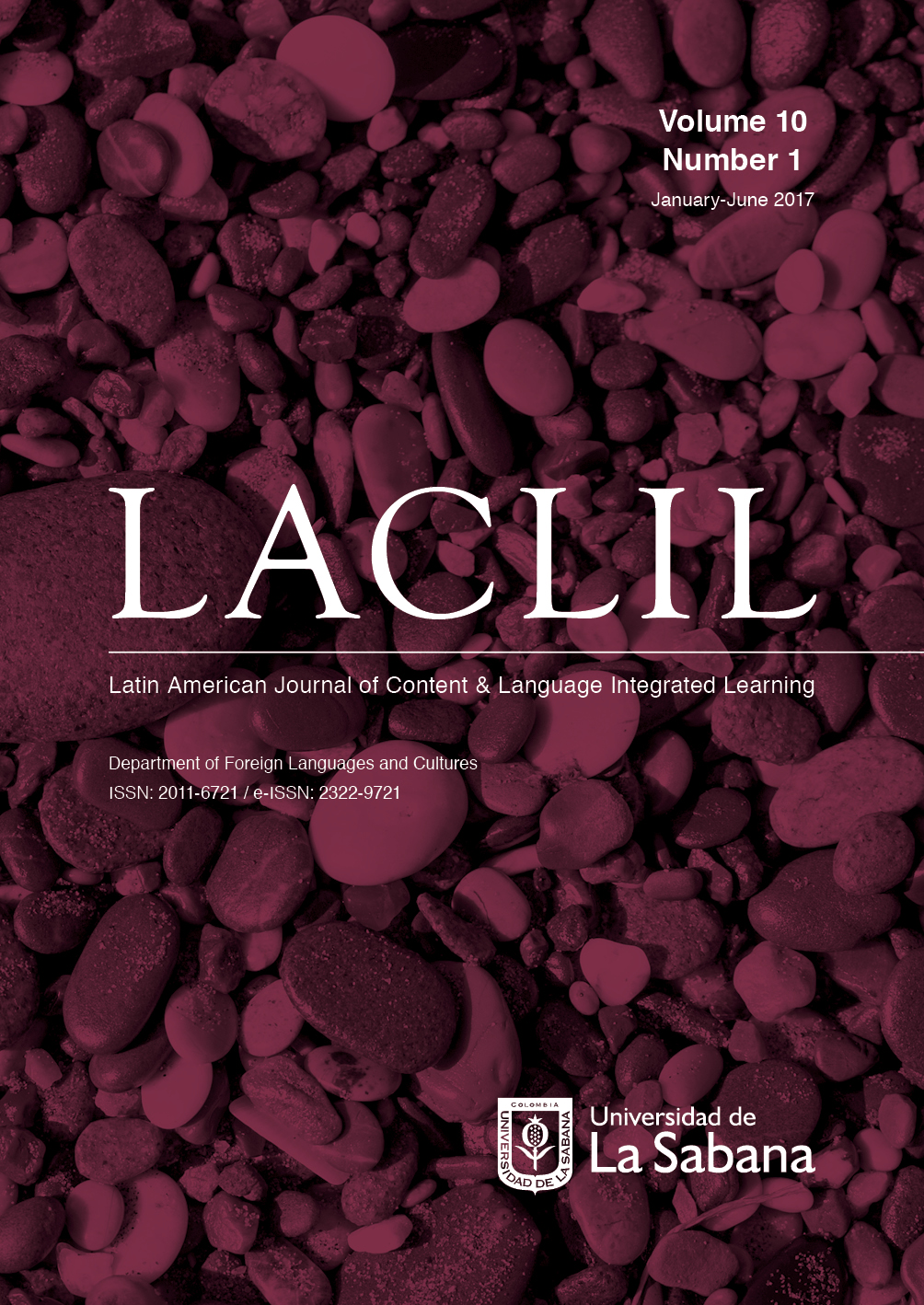Phrasebook: una salida para los maestros de CLIL en Tailandia
DOI:
https://doi.org/10.5294/laclil.v10i1.7259Keywords:
CLIL in Thailand, English integrated classroom, bilingual education in ThailandAbstract
Content and Language Integrated Learning (CLIL) is an alternative approach for En- glish teaching and learning that is in focus in Thailand today. Preparing Thai content teachers to con dently use English as a means of instruction in the English integrated classroom just as they do in the Thai monolingual classroom takes time and long-term nancial investment. Creating a classroom language manual for mathematics teachers to promptly use is a way out for those professionals who struggle with language. This article aims to examine the possibility of providing prefabricated classroom language sentences to Thai content teachers who need language support in order to identify the appropriateness of the components of the manual and the language for classroom use, in order to create a motif of language support for other subjects. In addition, this paper aims to explore Thai mathematics teachers’ perception toward the CLIL classroom. The phrasebook design was based on a unit of mathematics at the primary level for 25 Thai mathematics teachers to implement in their classes. The results revealed that the designed prefabricated phrasebook could be a way out. Prefabricated phrases should respond to the speci cation of mathematics concepts for each level. Ultimately, the CLIL concept should be clearly established for Thai content teachers to make CLIL classes effective and possible.
Downloads
References
Bax, S. (2010). Researching English Bilingual Education in Thailand, Indonesia and South Korea. Malaysia: British Council.
Cabezuelo Gutiérrez, P., & Fernández Fernández, R. (2014). A case study on teacher training needs in the Madrid bilingual project. Latin American Journal of Content and Language Integrated Learning, 7 (2), 50-70.
Chan, S. H., & Ain Nadzimah, A. (2015). Bilingualism in Malaysia: language education policy and local needs. Pertanika Journal Social Science & Humanities, 23 (5), 55-70.
Coyle, D., Hood, P., & Marsh, D. (2010). CLIL : Content and Language Integrated Learning. Cambridge: Cambridge University Press.
de Graaff, R., Koopman, G. J., Anikina, Y., & Westhoff, G. (2007). An observation tool for effective L2 pedagogy in Content and Language Integrated Learning (CLIL). International Journal of Bilingual Education and Bilingualism. 10(5), 603 - 624.
Dhanasobhon, S. (2007). English language teaching dilemma in Thailand. KUforest , 22 (1), 53-59.
Education First. (2015). EF English Proficiency Index. EF.
Eurydice. (2006). Content and Language Integrated Learning (CLIL) at School in Europe. Brussel, Belgium: European Commission.
Gajo, L. (2009, June 03). Enseignement d’une DNL en langue étrangère : de la clarification à la conceptualisation. Retrieved from Tréma: http://trema.revues.org/448
García, O. (2009). Bilingual Education in the 21st Century: A Global Perspective. Malden, MA: Wiley-Blackwell.
Kewara, P. (2012). Teaching and learning linguistic and non-linguistic subjects in primary education : analysing teachers and students’ joint action in primary bilingual classes in Thailand. Dissertation, Université Rennes 2, CREAD, Rennes.
Keyuravong, S. (2008). Content and Language Integrated Learning (CLIL) in Primary East Asia Context (Thailand). British Council.
Keyuravong, S. (2010). Insight from Thailand. In R. Johnstone, Learning Through English: Policies, Challenges and Prospects. Insight from East Asia (pp. 69-95). Malaysia: British Council.
Lantolf, J. P. (2000). Sociocultural theory and second language learning. Oxford, UK: Oxford University Press.
Lasagabaster, D., & Sierra, J. M. (2009). Immersion and CLIL in English: More differences than similarities. ELT Journal, 64 (4).
MacKenzie, A. (2008, April 11). CLILing me softly in Thailand: Collaboration, creativity and conflict. Retrieved from http://www.onestopenglish.com/clil/clil-teacher-magazine/your-perspectives/cliling-me-softly-in-thailand-collaboration-creativity-and-conflict/500927.article
Maidan Flores, J., & Abad, J. (1997). ASEAN at 30. Jakata: ASEAN Secretariat.
Marsh, D., & Wolff, D. (2007). Diverse Contexts - Converging Goals: CLIL in Europe (Vol. 6). Frankfurt: Peter Lang.
Mehisto, P., Marsh, D., & Jesùs Frigols, M. (2008). Uncovering CLIL. Thailand: Macmillan Education.
Muñoa Barredo, I. (2011). Key factors to be considered by CLIL teachers. In Y. Ruiz de Zarobe, J. M. Sierra, & F. Gallardo del Puerto (Eds.), Contribution to Multilingualism in European Contexts (293-316). Frankfurt-am-Main: Peter Lang.
Nikula, T., Dalton-Puffer, C., & Llinares, A. (2013). CLIL classroom discourse. Journal of Immersion and Content-Based Language Education , 1 (1), 70-100.
Novotná, J., & Hofmannová, M. (2002). Implementation of Content and Language Integrated Learning (CLIL) in mathematics classroom. In A. Cockburn, & N. Elena (Eds.), PMe26 Proceedings (Vol. 1, pp. 346-). UAE.
Office of Basic Education Commission (OBEC). (2014). Guidelines of teaching English reform. Retrieved from http://tesol-itecthailand.com/cefr-in-thailand/
Pérez Cañado, M. L. (2016). Are teacher ready for CLIL? Evidence from a European study. European Journal of Teacher Education , 39 (2), 202-221.
Pérez Cañado, M. L. (2014). Teacher training needs for bilingual education: in-service teacher perceptions. International Journal of Bilingual Education and Bilingualism, 19 (3), 266-295.
Rattanawit, S. (1990). Development of Teaching Thai Language by Focusing on Using the Language. Bangkok: Prayoonwong.
Schneider K., M. (1991). It's academic. An integrated skills content-based approach to language learning. Toronto: Maxwell Macmillan International Publishing Group.
Suwannoppharat, K., & Chinokul, S. (2015). Applying CLIL to English language teaching in Thailand: Issues and challenges. Latin American Journal of Content and Language Integrated Learning , 8 (2), 237-254.
Tarnpichprasert, M. (2009). Inside bilingual education in Thailand : staffroom and classroom perspectives. Doctorate dissertation, University of Warwick.
The Ministry of Education. (2001). English and Mini English Program Act. Government Document.
Downloads
Published
How to Cite
Issue
Section
License
This Journal and its articles are published under the Creative Commons CC BY 4.0 DEED Attribution 4.0 International license. You are free to: Share — copy and redistribute the material in any medium or format for any purpose, even commercially. Adapt — remix, transform, and build upon the material for any purpose, even commercially. The license cannot revoke these freedoms as long as you follow the terms of the license.








